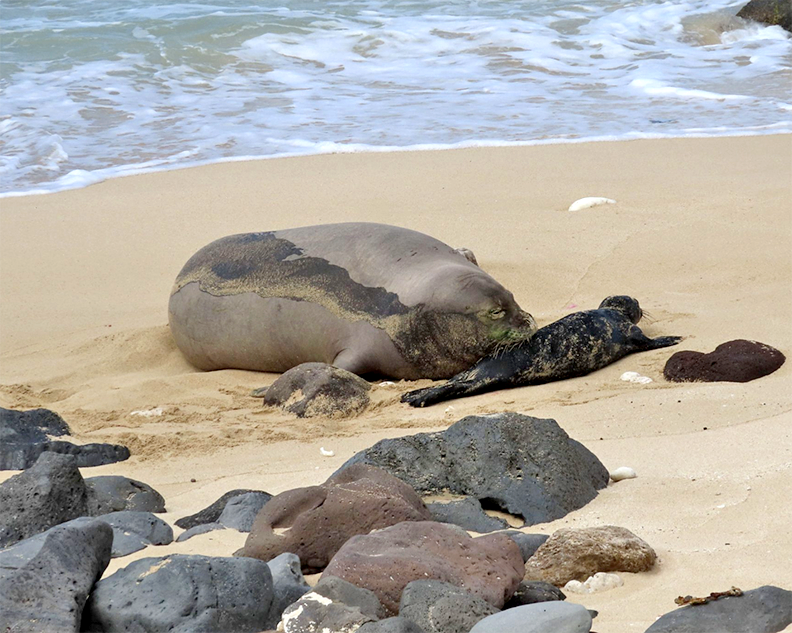By Tommy Noyes

JR and Esther Estes visited from Waimea, Kaua‘i’s Westside, and bicycled Ke Ala Hele Makalae for the first time in August 2013. Ms. Estes said they rode their Harley motorcycle and saw the path at Kealia Beach, ‘so we though we’d check it out.’
Learning about an unfamiliar area’s unique characteristics is a sure way to enrich a visitor’s experience. The same may be true for gaining a deeper appreciation of your local surroundings — understanding the factors that shaped your home town.
Ke Ala Hele Makalae, East Kaua‘i’s coastal path system, now features more than two-dozen cultural markers and interpretive signs spread from the south side of Wailua River to the mysterious and massive concrete relic — the “Pineapple Dump” — near Kuna Bay. Path users are presented with geographical, ecological, cultural and social information illuminating a broad range of the area’s heritage.
Back in 1999, one challenge facing “Kaua‘i’s Health and Heritage Corridor” working task force (convened by then County Councilman Bryan Baptiste) was how to perpetuate and accurately convey the location’s cultural story. The task force compiled much of the content that eventually was used as the basis for the interpretive signage series. The interpretive materials reward path users as they explore or re-visit the coast.
In fact, the interpretive series won acclaim for the county. A media release issued by the County Department of Public Works states, “The County of Kaua‘i recently received a Preservation Honor Award from the Historic Hawai‘i Foundation for its series of interpretive signs that are placed along Ke Ala Hele Makalae, the Path that Goes by the Coast. The series is called the Puna Moku Coastal Trail Heritage Signage.
“‘We are honored to be recognized for our efforts to promote preservation and appreciation for the area’s cultural heritage,’ said Mayor Bernard Carvalho, Jr. ‘A big mahalo goes to everyone who’s been involved in this project over the years, including: Calvin Miyahara with KSF Inc.; Doug Haigh, Kaua‘i County Building Division chief; Jim Powell and Michael Dega, Scientific Consultant Services, Inc.; and Stan Duncan, PBR Hawai‘i and Associates, Inc.’”
The interpretive signage explains how the river and coastal geology, ecology, flora, and fauna shaped the environment.
Over time people came to the island, bringing their culture, erecting monuments, and establishing commerce. Tiles set into the path demarcate ancient ahupua‘a boundaries.
The signage tells the stories of many generations of Kapaa’s inhabitants: Those who sailed the Pacific in voyaging canoes, established a monarchy and built the complex of heiau in Wailuanuiaho‘ano (“Great Sacred Wailua”); the ferry operators that predated bridges at Wailua River; the rice farmers who cultivated paddies in Kapa‘a; the Kealia sugar mill workers who lived in its camps; the Japanese immigrants who raised a massive stone lantern honoring the their homeland’s Emperor, then buried the lantern to hide it from potential persecutors, and those who discovered, relocated and eventually restored the lantern in its present setting in Kapa‘a Beach Park; the factory workers in the Pono Pineapple cannery; and of course, Elvis floating along the Coco Palms iconic lagoon.
Go see for yourself — you might learn something!
- Tommy Noyes works for the Hawai‘i State Department of Health’s Public Health Preparedness branch, serves on Kaua‘i Path’s board of directors, and is a League of American Bicyclists certified instructor.
Discover more from ForKauaiOnline
Subscribe to get the latest posts sent to your email.





Leave a Reply